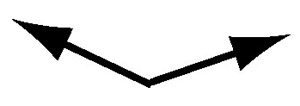 |
Conservation Laws |
 |
Conservation Laws - Data Analysis Using Graphs - Histograms - Units or Vectors in Particle Physics
In all of physics there are only six conservation laws. Each describes a quantity that is conserved, that is, the total amount is the same before and after something occurs. These laws have the restriction that the system is closed, that is, the system is not affected by anything outside it.
Conservation of charge
Conservation of momentum
Conservation of mass/energy
Conservation of angular momentum
Conservation of baryons
Conservation of leptonsLet's review the conservation laws that you know from classical physics. Then, we will describe two particle physics conservation laws.
Conservation of Charge
This is used all the time in chemistry. The total charge in the system is conserved.
NaOH + HCl Check this interaction of particles:?
Na+OH- + H+Cl-Na+ Cl- + H+ OH-
salt in water
1+ + 1- + 1+ + 1- = 0 = 0 + 0
p+ + no p+ + p+
1+ + 01+ + 1+
12. This reaction cannot happen!
Conservation of Momemtum
Momemtum, p, (a vector) equals mass, m, (a scalar) times velocity, v, (a vector).
(p = m v) Consider a collision of toy cars:
Before Collision After Collision m1 = 1 kg m2 = 2 kg m1 = 1 kg m2 = 2 kg v1 = +5 m/s v2 = -5 m/s v1' = -3 m/s v2' = -1 m/s Calculate total velocity and total momentum before and after the collision. Remember that v and p are vectors.
Before Collision After Collision m1 = 1 kg m2 = 2 kg m1 = 1 kg m2 = 2 kg Sv = +5 m/s + - 5 m/s = 0 Sv = -3 m/s + -1 m/s = -4 Sp = +5 kg m/s + -10 kg m/s
= -5 kg m/sSp = -3 kg m/s + -2 kg m/s
= -5 kg m/sSo, total velocity is NOT conserved, but momentum is!
Look at these particle tracks (as calculated by a computer) as an electron and positron collide. What do you conclude?
Before: After:

It looks as if momentum is not conserved unless there is one or more unseen particle.In the 1930s, when conservation of momentum seemed to be violated in such events, particle physicists realized that there must be unseen particles. That is how neutrinos were first postulated, but they weren't discovered until much later.
Conservation of Energy/Mass
Consider the following reaction:po In the reference frame in which the po is at rest, there is no initial kinetic energy, but since the photons are moving, there is clearly kinetic energy in the final state. What is the source of this energy? The mass of the po has been converted into kinetic energy (KE). In other words, mass is a form of energy, E = mc2, often called the rest mass energy (RME). Now, the conservation of energy takes the following form:g g. That is, po (pi-zero) decays into 2 photons.
KEi + RMEi = KEf + RMEf. In this example KEi = 0. Note, potential energy need not be considered because the initial and final states are non-interacting.
Conservation of Angular Momentum
Angular momentum (L) involves the position of the mass (R), as well as its angular velocity, w.
L = m R v = I w As a star collapses (or an ice skater pulls in her arms), R gets smaller, If angular momentum is conserved, either m or v must increase, when R decreases. Increasing v for an ice skater is much easier than increasing m! An inrease in v allows conservation of L.
m1 R1 v1 = m2 R2 V2
Spin
Sometimes you hear about "spin" of electrons or other particles.
How can particles with "no dimensions" have spin? And, how can it be an intrinsic characteristic? After all, a baseball doesn't keep its spin when you catch it.
Scientific American's Ask the Expert gives information about spin and the history of its name.
IEEE's The Quest for the Spin Transistor discusses spin and tells about more recent studies.Conservation of Baryon Number
Baryons are hadrons (composite particles made of quarks) composed of any three quarks. Baryon number is conserved in a reaction. You must count each baryon as +1 and each antibaryon as -1. Non-baryons have a baryon number of 0.
p- + p+ no + p- + p+
This is an observed event that conserves both electric charge and baryon number.p+
p+ + po
This conserves charge but not baryon number, so does not happen.Conservation of Lepton Number
There are six leptons: three have electric charge and three, called neutrinos, do not. The electron is the best known lepton. The tau and the muon are the other two charged leptons. Each neutrino is associated with one of the charged leptons.Lepton number is also conserved in reactions. Again, leptons have lepton number of +1, antileptons have -1, and non-leptons have 0.
e+ + e- p+ + p-
This is an observed event that conserves both electric charge and baryon number.p-
e- + g
Charge is conserved, but lepton number is not. There are no leptons on the left, but there is one on the right. This cannot happen.In case you wonder, there is NO conservation law for the third type of particles, mesons, such as p.
